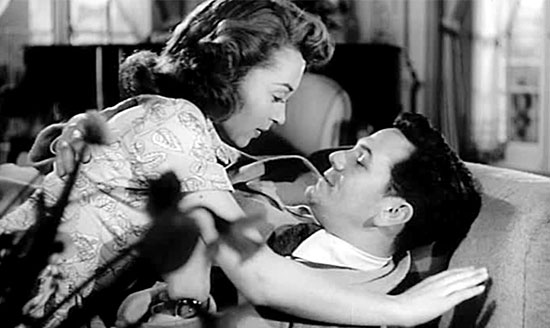Classic Hollywood: Films of ’47: Body and Soul

I’ve seen more classic boxing movies than matches in my lifetime. Golden Boy, The Set-Up, Champion, The Harder They Fall, Rocky, Raging Bull. The truth is, if I cared any less about men pummeling each other for money, it would be an effort. My limited interest is in the back stories of the big-screen boxers. Why do they fight? What compromises are they willing to make?
In 1947, the New York Times spotlit the downside of the genre: “After all the assorted prizefight pictures that have been paraded across the screen—after all the pugs and mugs and chorus girls and double-crosses and last-round comebacks that we’ve seen—it hardly seemed likely that another could possibly come along with enough zing and character to it to captivate and excite us for two hours. Yet Body and Soul has up and done it, with interest and excitement to spare, and we heartily recommend it.”
As a teen, I watched Body and Soul because I had a crush on John Garfield. Smitten at first sight after watching his screen debut in Four Daughters (1938), I just thought he was one hot dude. A breath of fresh air amidst the pretty boys of the period, Garfield was a bad boy, with a tough exterior that masked a tender heart, a New York actor in voice, unfussy acting style, and attitude.
While under contract to Warner Bros., Garfield dutifully performed in studio programmers of average quality with self-descriptive titles like They Made Me a Criminal and Dust Be My Destiny. He demonstrated greater range in the ’40s with Pride of the Marines, The Postman Always Rings Twice, and the cinematic soap Humoresque opposite Joan Crawford.
You could say 1947 was the high-water mark of Garfield’s career with the release of Oscar winners Body and Soul and Gentleman’s Agreement on the same day. I admire the latter but prefer the former, even if it’s “just” a boxing pic. That split decision is due to Garfield’s nuanced performance as Charley Davis, a fighter whose drive to succeed blinds him to the compromises made on the way up that will haunt him on the way down. Charley sells out everyone – his mother, girlfriend, best friend – but most of all himself until he bravely takes a stand in his final bout.
Charley’s moral journey makes for a serious, engrossing drama. You see how Charley rationalizes his behavior, certain that once he triumphs in the ring, he can get his scruples out of hock. Garfield’s independent production company released the film, putting the performer in charge of hiring everyone from writer Abraham Polonsky (who won an Oscar nod for his script), to cinematographer James Wong Howe (who shot the fight sequences on roller skates!), to Canada Lee, a real-life fighter-turned-actor, as Charley’s rival and trainer.
Despite the critical and box-office success of Body and Soul, Garfield, Polonsky, and Lee became prominent victims of the Hollywood blacklisting era. Sadly, the stress of the “red” smear led to the untimely deaths of co-stars Garfield (age 39) and Lee (age 45), twelve days apart in May of 1952. To the end, Garfield refused to name names and it cost him his career. “He ratted out no one,” writes film noir czar Eddie Muller. Or as Polonsky put it, Garfield “defended his street boy’s honor and they killed him for it.”
Classic Hollywood posts appear bimonthly on The Music Hall blog.
